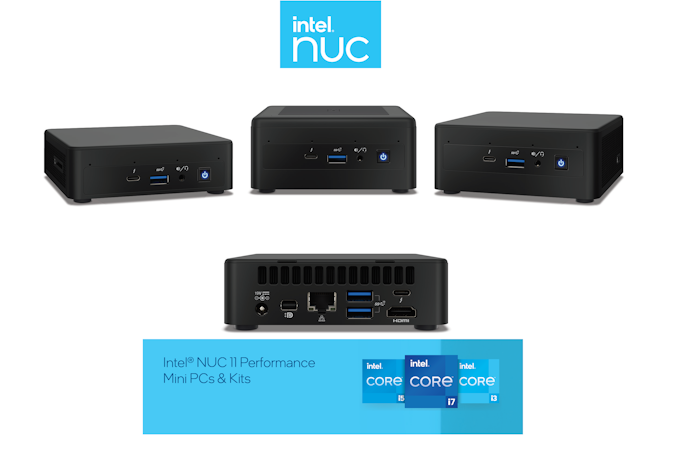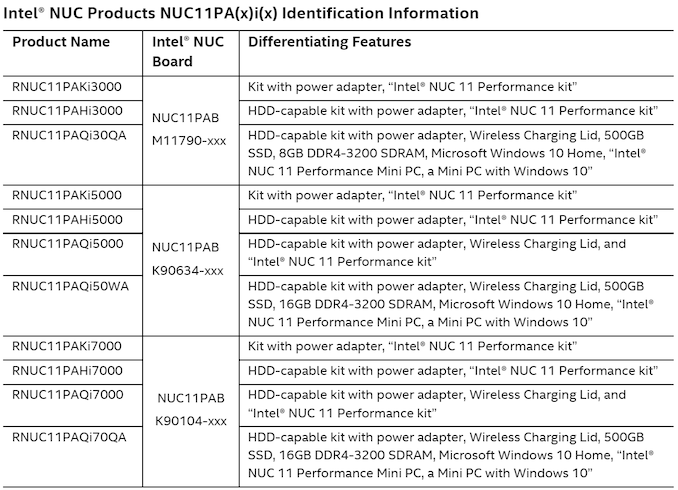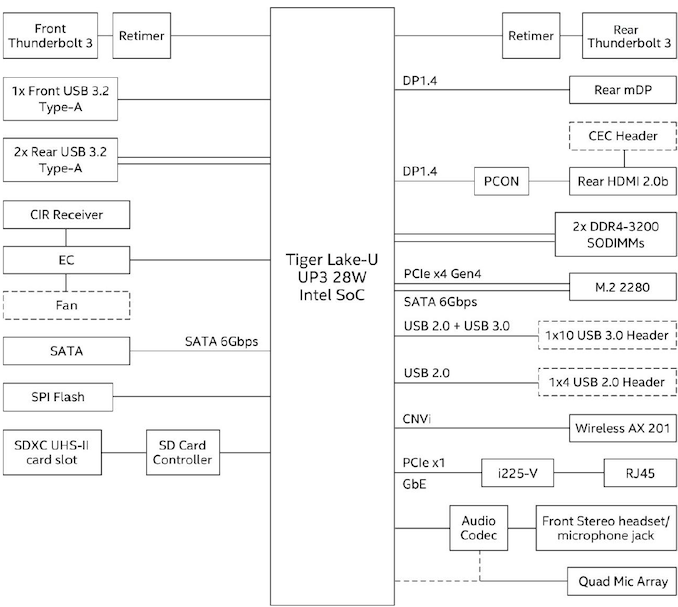Intel Unveils Panther Canyon NUC11 Family: Tiger Lake Comes to NUCs
by Ganesh T S on January 18, 2021 8:00 AM EST- Posted in
- Systems
- Intel
- Trade Shows
- NUC
- Tiger Lake
- CES 2021
- NUC11

As part of its CES 2021 announcements, Intel officially unveiled a number of NUCs based on their Tiger Lake SoCs. Intel's initial NUCs were all based on 100mm x 100mm (4in x 4in) boards, kickstarting the UCFF craze that contributed to revitalizing the PC market. Over the last few years, we have seen Intel expand the NUC to encompass multiple other form-factors, while keeping compactness in mind:
- Performance: The original 4x4 UCFF units
- Pro: 4x4 UCFF units with expansion support and vPro capabilities
- Compute Elements: Add-in Card form factor with carrier boards for system design
- Extreme: Compute Elements using a 45W TDP processor with a base board hosting up to three PCIe expansion slots (inclusive of a M.2 22110 NVMe slot) and a 5L chassis enabling compact gaming and workstation PCs
- Rugged: NUCs designed for operation in industrial and factory-floor type environments, sporting processors based on the Atom microarchitecture
- Essential: 4x4 NUCs sporting processors based on the Atom microarchitecture
- Laptop Kit: Reference design / whitebook models for OEMs to bring notebooks to market faster
- Enthusiast: Compact PCs with a 5.5in. x 8in. motherboard sporting a discrete GPU (either soldered or in-package)
The Panther Canyon NUCs are the Tiger Lake-based "Performance-class" units, with eleven different SKUs based on three different boards.
All the models operate the Tiger Lake processors (Core i7-1165G7, Core i5-1135G7, or the Core i3-1115G4) with a TDP of 28W. The K and H kits are the usual ones we have seen in previous generations - the latter has support for the installation of a 2.5" drive. Panther Canyon also has a Q SKU that adds a wireless charging lid (up to 15W) on top of the H chassis. The specifications are summarized in the table below.
| Intel Panther Canyon NUC (Tiger Lake-U) Lineup | ||||
| Model | NUC11PA{K/H/Q}i3 | NUC11PA{K/H/Q}i5 | NUC11PA{K/H/Q}i7 | |
| CPU | Intel Core i3-1115G4 2C/4T 1.7 - 4.1 GHz (3.0 GHz) 12 - 28 W (28W) |
Intel Core i5-1135G7 4C/8T 0.9 - 4.2 GHz (2.4 GHz) 12 - 28 W (28W) |
Intel Core i7-1165G7 4C/8T 1.2 - 4.7 GHz (2.8 GHz) 12 - 28 W (28W) |
|
| GPU | Intel® UHD Graphics for 11th Gen Intel® Processors (48EU) @ 1.25 GHz | Intel® Iris® Xe Graphics (80EU) @ 1.3 GHz | Intel® Iris® Xe Graphics (96EU) @ 1.3 GHz | |
| DRAM | Two DDR4 SO-DIMM slots Up to 64 GB of DDR4-3200 in dual-channel mode |
|||
| Motherboard | 4.13" x 4.16" UCFF | |||
| Storage | SSD | 1x M.2-2280 (PCIe 4.0 x4 (CPU-direct) or SATA III) | ||
| DFF | 1 × SATA III Port (for 2.5" drive) | |||
| Card Slots | Full-sized SDXC UHS-II | |||
| Wireless | Intel Wi-Fi 6 AX201 2x2 802.11ax Wi-Fi + Bluetooth 5.1 module |
|||
| Ethernet | 1 × 2.5 GbE port (Intel I225-V) | |||
| USB | Front | 1 × USB 3.2 Gen 2 Type-A 1 x Thunderbolt 3 Type-C |
||
| Rear | 2 × USB 3.2 Gen 2 Type-A 1 × Thunderbolt 3 |
|||
| Display Outputs | 1 × HDMI 2.0b 1 x mini-DP 1.4a 2 × DisplayPort 1.4 (using Thunderbolt 3 Type-C ports) |
|||
| Audio | 1 × 3.5mm audio jack (Realtek) | |||
| PSU | External (90W) | External (120W) | ||
| Dimensions | Length: 117 mm Width: 112 mm Height: 38mm (K), 51mm (H), 56mm (Q) |
|||
| MSRP | ? | ? | ? | |
Intel's technical product specifications provide additional details on the I/Os. We see the front and rear Thunderbolt ports (curiously, marketed as Thunderbolt 3 instead of Thunderbolt 4) are enabled directly from the TGL-U processor. Two display outputs (DP 1.4a) are also routed through these Thunderbolt ports within the processor itself.
Interestingly, a protocol converter is still needed on the board to convert the DP 1.4a display output to HDMI 2.0b. There is a PCIe 4.0 x4 lanes set for attaching a NVMe SSD. The high-speed I/O lanes are multiplexed with a SATA port allowing the installation of a M.2 SATA SSD in the same slot. The LAN port is enabled by the i225-V 2.5 Gbps controller, while the SDXC card slot on the side requires an additional SDXC bridge chip. The Wi-Fi 6 capabilities are enabled by the soldered Intel AX201 CNVi card.
Panther Canyon looks to be a solid upgrade over the Frost Canyon NUC despite the loss of a couple of cores (the Frost Canyon NUC was a hexa-core affair), thanks to the improved CPU microarchitecture and a host of system-level upgrades. On the latter front, we have an additional Thunderbolt port, a 2.5 Gbps LAN port (compared to the regular Gigabit port in the Frost Canyon NUC), ability to install a PCIe 4.0 NVMe SSD, and the ability to drive up to four 4Kp60 displays. Additionally, we also have some of the Panther Canyon SKUs sporting a 15W wireless charging lid.
Various reseller listings have come up for the Panther Canyon NUCs in Europe. However, Intel has not provided a concrete launch date or pricing details for any of the SKUs yet.
Source: Intel












43 Comments
View All Comments
vladx - Tuesday, January 19, 2021 - link
TB4 uses new controller which most likely requires redesigning the motherboard with no real benefits over TB3 besides stricter rules which don't matter in this case as Intel themselves handles the designing. TB4 is only important for 3rd party products that use minimum required specs in the standard.Deicidium369 - Thursday, January 21, 2021 - link
Every NUC generation is a new design - not like they are taking the NUC10 and putting a TGL in it.abufrejoval - Friday, February 19, 2021 - link
That's what I thought, too, but it doesn't seem to be the case. Real SoC (or PCH) PCIe lanes need to be allocated to a TB controller, which will then require another TB chip to translate it back into whatever you want on the side (USB/display/PCIe).abufrejoval - Friday, February 19, 2021 - link
Shoot, reread the article and now I'm just really confused... please ignore my last comment.AdditionalPylons - Monday, January 18, 2021 - link
I would normally be super excited about new NUCs. Now I'm just waiting for a Ryzen 5000 based version of one of these:https://www.gigabyte.com/Mini-PcBarebone/GB-BRR7H-...
https://www.asrockind.com/en-gb/4X4%20BOX-4800U
https://www.asus.com/Displays-Desktops/Mini-PCs/Al...
https://www.asrock.com/nettop/AMD/Mars%204000U%20S...
As others already mentioned, the Intel ones do have a Thunderbolt advantage.
Plus I'm glad to see 2.5 GbE is standard! (Compared to the links above, the Gigabyte and AsrockInd also have it, but not the other two.)
Skeptical123 - Monday, January 18, 2021 - link
I could not agree more, I suspect a we are not alone and this product segment will continue to heatup.powerarmour - Monday, January 18, 2021 - link
I still prefer my Hades Canyon over these new ones tbh, they've actually reduced the display outputs, no dual LAN etc, and a last gen Turing is a bit odd (instead of their own DG/Xe Graphics), but still a lot of power for a small size again.Even the i7-8809G CPU is still slightly faster than an i7-1165G7
Deicidium369 - Monday, January 18, 2021 - link
The Performance line is the low end model - with the Pro line coming with the 1185G7.https://ark.intel.com/content/www/us/en/ark/produc...
offers the 2nd 2.5Gb/s NIC and the 1185G7.
Jorgp2 - Monday, January 18, 2021 - link
it has four outputsava1ar - Wednesday, January 20, 2021 - link
Hades Canyon has 6 outputs, so comparing to it 4 is definitely a downgrade.